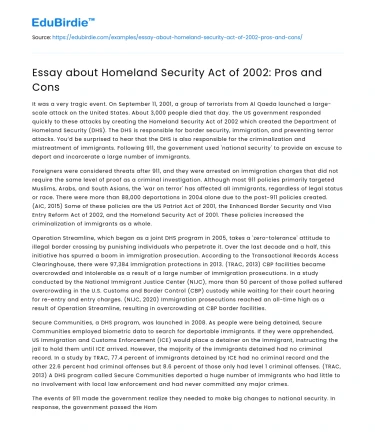It was a very tragic event. On September 11, 2001, a group of terrorists from Al Qaeda launched a large-scale attack on the United States. About 3,000 people died that day. The US government responded quickly to these attacks by creating the Homeland Security Act of 2002 which created the Department of Homeland Security (DHS). The DHS is responsible for border security, immigration, and preventing terror attacks. You’d be surprised to hear that the DHS is also responsible for the criminalization and mistreatment of immigrants. Following 911, the government used 'national security' to provide an excuse to deport and incarcerate a large number of immigrants.
Foreigners were considered threats after 911, and they were arrested on immigration charges that did not require the same level of proof as a criminal investigation. Although most 911 policies primarily targeted Muslims, Arabs, and South Asians, the 'war on terror' has affected all immigrants, regardless of legal status or race. There were more than 88,000 deportations in 2004 alone due to the post-911 policies created. (AIC, 2015) Some of these policies are the US Patriot Act of 2001, the Enhanced Border Security and Visa Entry Reform Act of 2002, and the Homeland Security Act of 2001. These policies increased the criminalization of immigrants as a whole.
Save your time!
We can take care of your essay
- Proper editing and formatting
- Free revision, title page, and bibliography
- Flexible prices and money-back guarantee
Operation Streamline, which began as a joint DHS program in 2005, takes a 'zero-tolerance' attitude to illegal border crossing by punishing individuals who perpetrate it. Over the last decade and a half, this initiative has spurred a boom in immigration prosecution. According to the Transactional Records Access Clearinghouse, there were 97,384 immigration protections in 2013. (TRAC, 2013) CBP facilities became overcrowded and intolerable as a result of a large number of immigration prosecutions. In a study conducted by the National Immigrant Justice Center (NIJC), more than 50 percent of those polled suffered overcrowding in the U.S. Customs and Border Control (CBP) custody while waiting for their court hearing for re-entry and entry charges. (NIJC, 2020) Immigration prosecutions reached an all-time high as a result of Operation Streamline, resulting in overcrowding at CBP border facilities.
Secure Communities, a DHS program, was launched in 2008. As people were being detained, Secure Communities employed biometric data to search for deportable immigrants. If they were apprehended, US Immigration and Customs Enforcement (ICE) would place a detainer on the immigrant, instructing the jail to hold them until ICE arrived. However, the majority of the immigrants detained had no criminal record. In a study by TRAC, 77.4 percent of immigrants detained by ICE had no criminal record and the other 22.6 percent had criminal offenses but 8.6 percent of those only had level 1 criminal offenses. (TRAC, 2013) A DHS program called Secure Communities deported a huge number of immigrants who had little to no involvement with local law enforcement and had never committed any major crimes.
The events of 911 made the government realize they needed to make big changes to national security. In response, the government passed the Homeland Security Act of 2002 which created the DHS. As a result, the DHS created several policies that would deport and incarcerate large numbers of immigrants. They created the Open Streamline program which caused immigration prosecutions to be at an all-time high and the Secure Communities program which would deport a huge number of immigrants who had no contact with law enforcement in the past. The government used “national security” to provide an excuse for the mass incarceration and mistreatment of immigrants.






 Stuck on your essay?
Stuck on your essay?

